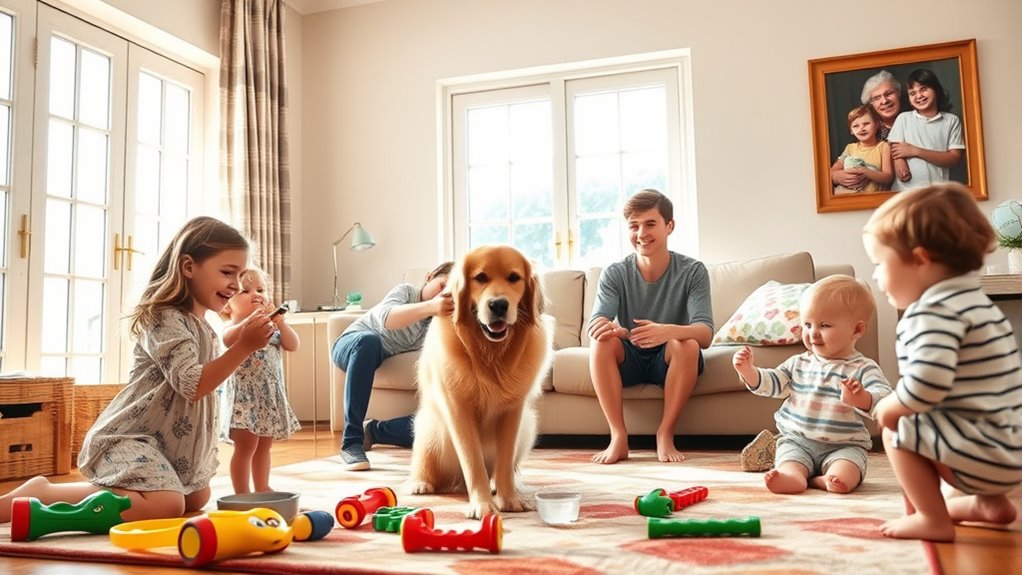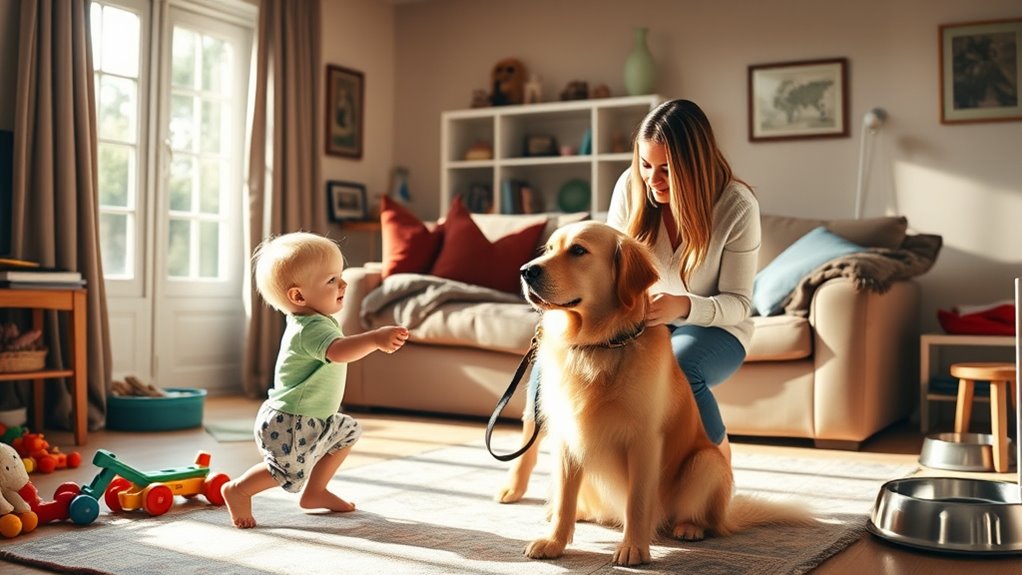Integrating pets into family life helps you teach responsibility and strengthen family bonds. By assigning age-appropriate pet care tasks, kids learn attentiveness and improve their confidence through positive reinforcement. Pets provide emotional support and reduce stress during tough times, enhancing personal growth. Financial responsibilities come into play, too, with costs for care and veterinary services. If you want to discover more about the countless benefits of having pets and tips for successful integration, keep exploring!
Key Takeaways
- Involving children in age-appropriate pet care tasks fosters responsibility and attentiveness towards animals.
- Pets enhance family dynamics by strengthening emotional bonds and providing unconditional love during challenging times.
- Routine veterinary care and emergency preparedness are essential for financial responsibility in pet ownership.
- Engaging with pets promotes personal growth in children, teaching empathy and enhancing family interactions.
- Pets encourage physical activity and improve mental health, benefiting both children and adults in the household.
The Growing Importance of Pets in American Households

Pets have become an integral part of American households, reflecting a significant cultural shift over the years. As of 2024, 66% of households own pets, surpassing those with children due to declining birth rates. You might find it interesting that pet spending has skyrocketed from $53.3 billion in 2012 to $147 billion in 2023, showing how much you value your furry companions. Dogs and cats dominate as the most popular pets, but freshwater fish are also common. This rise in pet ownership mirrors changes in family structures and lifestyles, emphasizing companionship and emotional support. With pets now viewed as family members, it’s clear they play a vital role in your life, enhancing your well-being and family dynamics. Additionally, this trend highlights the decline of households with children, further emphasizing the shift in priorities towards pet companionship.
Teaching Responsibility Through Pet Care

As family dynamics shift and pets take on a more prominent role, teaching responsibility through pet care becomes increasingly important. You can start by assigning age-appropriate tasks; younger kids can help with simple chores, while older children can take on more independent responsibilities. Encouraging your kids to observe their pets’ needs fosters attentiveness and responsiveness. Establishing consistent routines for feeding and grooming reinforces responsibility. Studies show that pet therapy can enhance emotional well-being, making it beneficial for both children and pets alike. By discussing mistakes together, you guide them in learning and improving their care techniques. Additionally, involving your children in pet care helps them build their immune systems through exposure to different germs. Celebrate their efforts with positive reinforcement to boost their confidence. Ultimately, these experiences cultivate empathy, time management, and problem-solving skills, equipping your children with valuable life lessons that extend beyond pet care.
Enhancing Family Dynamics With Pets

When you welcome a pet into your home, you’re not just adding a furry companion; you’re also enriching your family dynamics. Pets often become integral family members, strengthening emotional bonds and enhancing relationships within your household. Their unconditional love provides support and helps everyone feel more connected, especially during tough times. You might find that conversations flow more easily, as many people engage with their pets as if they’re family. Furthermore, pets can ease tensions during conflicts, offering a neutral presence that helps stabilize family interactions. They also encourage personal growth in children, teaching empathy and responsibility. In addition, having access to library services can help families find resources on pet care and training. Regular outings for puppy socialization can also provide opportunities for family bonding and fun experiences. Moreover, engaging with pets can promote emotional well-being, ultimately making your family unit stronger, fostering a nurturing environment that thrives on love and companionship. Providing proper care, including routine checkups, ensures that pets remain healthy and happy, further enhancing the joy they bring to family life.
Financial Responsibilities and Veterinary Care

Welcoming a pet into your family comes with its share of financial responsibilities that you should consider before making a commitment.
The first year alone can cost between $1,000 and $3,000 for vaccinations, spaying, and other essentials. After that, expect annual expenses between $800 and $1,200.
Don’t forget emergency costs, which can range from $200 to $1,000 or more. Regular veterinary care, including routine check-ups and preventive treatments, is vital for your pet’s health and adds to ongoing expenses.
Additionally, maintaining a proper diet may require special food or medications, especially as your pet ages. In fact, the average annual cost of routine care for dogs can be between $200 and $400.
Considering pet insurance can help cushion unexpected costs, averaging $30 to $50 monthly for dogs and less for cats.
Health Benefits of Pet Ownership

Owning a pet brings a wealth of health benefits that extend beyond just companionship.
Pets encourage you to stay active, especially dogs, which helps maintain a healthy weight and lowers the risk of heart disease. You’ll likely experience lower blood pressure and improved survival rates if you face health challenges.
Mentally, pets reduce stress and combat feelings of loneliness, providing a calming presence that enhances your emotional well-being. Early exposure to pets even boosts children’s immune systems and teaches them essential lessons about responsibility.
As you age, pets can improve cognitive health and increase physical activity, contributing to a longer, healthier life.
Overcoming Challenges in Pet Care and Ownership

While pet ownership can be incredibly rewarding, it also comes with its fair share of challenges that require careful consideration.
Financially, you need to account for initial costs like adoption fees, ongoing expenses for food and vet visits, and unexpected medical emergencies. Investing in pet insurance can help alleviate some of these burdens. Additionally, routine veterinary check-ups can help identify potential health issues early, allowing for timely interventions that can save money in the long run. Providing nutritious foods such as safe fruits can also contribute to long-term health and reduce veterinary costs. Choosing quality dog foods specifically formulated for your pet’s breed can enhance their overall well-being.
Time-wise, balancing pet care with your schedule can be tough; establishing routines and involving the whole family in pet responsibilities is essential. Regular exercise and playtime are vital for your pet’s well-being, which can help foster a stronger bond within the family.
Behavioral issues can arise too, such as separation anxiety or stress-related scratching. Regular training and veterinary consultations can address these problems. Understanding routine health checks can also play a crucial role in maintaining your pet’s well-being.
Utilize educational resources and support groups to share experiences, ensuring you’re well-prepared for the responsibilities of pet ownership.
Frequently Asked Questions
How Can Pets Help With Children’s Emotional Development?
Pets can greatly enhance your child’s emotional development. When they interact with pets, they learn to recognize and respond to non-verbal cues, fostering empathy.
This bond helps them manage stress and anxiety, as pets offer unconditional love and acceptance. By discussing their pets’ emotions, you encourage deeper exploration of feelings.
Caring for a pet also teaches responsibility, which bolsters their ability to form trusting relationships with others, enhancing their social skills.
What Age Is Appropriate for a Child to Take on Pet Care?
The right age for a child to take on pet care varies, but it generally begins around age 4 or 5 for simple tasks like pouring food or gentle petting.
By ages 7 to 12, kids can take on more responsibilities, such as feeding and bathing pets with your supervision.
As children reach their early teens, they can manage more complex tasks, fostering a sense of responsibility and connection with their pets.
How Do Pets Influence Family Routines and Schedules?
Pets greatly influence your family routines and schedules. You’ll find yourself establishing regular feeding and walking times, which often brings everyone together.
This commitment may lead you to adjust your daily plans, ensuring everyone shares in pet care responsibilities. As you navigate these changes, you might notice increased social interactions with other pet owners during walks.
Ultimately, pets can create a structured yet fulfilling rhythm in your family’s daily life.
What Are the Best Pets for Families With Young Children?
Imagine a sunlit garden where laughter dances among playful paws. For families with young children, dogs and guinea pigs are like the warm hugs of friendship, offering loyalty and joy.
Cats bring a touch of independence, while fish glimmer like tiny jewels, teaching care with minimal fuss.
Each pet, from cuddly to colorful, can become a cherished companion, enriching your family’s life and creating memories that shine brighter than any summer day.
How Can Families Handle Pet Care During Vacations?
When you’re planning a vacation, handling pet care can feel overwhelming. Start by researching local pet care options early to guarantee availability.
Visit boarding facilities or meet pet sitters to gauge their reliability. Create a care plan detailing feeding and exercise needs, and leave emergency contact info.
Regular updates from caregivers can ease your mind. Remember, familiar items can comfort your pets, making the change smoother for everyone involved.
Conclusion
Integrating pets into your family life isn’t just about companionship; it’s a journey of shared responsibilities and growth. As you navigate the joys and challenges of pet ownership, you’ll find that these furry friends enrich your lives in unexpected ways. Embracing the occasional mess and the financial commitments that come with them can lead to deeper bonds and healthier lifestyles. In the end, the love and lessons learned from your pets will be worth every effort you put in.









